Awakening to the Anger Abroad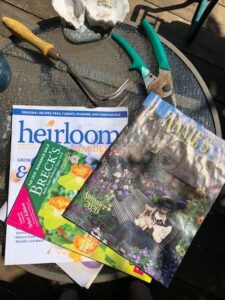
When I awakened on Thursday morning after the attack on our national capitol, I felt as if the world had tipped on its axis. I was disoriented and frightened. So I did what I always do when I’m feeling down. I headed for my garden.
My last post about gardening was in August when I stripped the leaves from several lettuce plants that had bolted during a heatwave, sending up thick stalks ending in flowers over a foot high. The leaves on the stalks, I was pleased to learn, were not bitter, and served as the base for several delicious end-of-summer salads. Since then my vegetable beds, both behind my house and in my front patio, have served up kale, bok choi, carrots, potatoes, and parsley, as well as the perennial herbs I tucked away in odd corners of the garden. Then the freezing nights arrived, and heavy rain and everything looked pretty sad.
One rainy day in late December I pulled out last year’s seed catalogs and, poured over them, dreaming of what I would plant this year. By January 7 I was itching to dig up the spent plants, loosen the soil, fertilize, and properly plan my spring garden. This would be my way of saying goodbye and good riddance to 2020. Getting my hands dirty would both help to soothe my pain and express my hope for the new year.
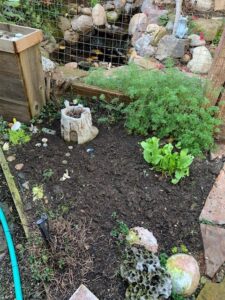 I pulled up the spent eggplant bushes and rambling sage sprouts, refreshed the soil, and made a little fairy garden against the day when once again my grandchildren will be able to visit. When the soil warms up I’ll replant this patch with herbs and add a few more fairy garden elements. After an hour in the garden, I felt ready to handle the day.
I pulled up the spent eggplant bushes and rambling sage sprouts, refreshed the soil, and made a little fairy garden against the day when once again my grandchildren will be able to visit. When the soil warms up I’ll replant this patch with herbs and add a few more fairy garden elements. After an hour in the garden, I felt ready to handle the day.
The Allotment Tradition
Planting vegetables in family-sized plots is a long-standing tradition in my family, dating back to the allotments my English grandparents worked in the early 1900s. According to John Harrison, who writes a calendar blog for UK gardeners, the history of allotments in the UK goes back over a thousand years to when the Saxons would clear a field from the woodland that would be held in common and used to grow food. At the beginning of 2020, 330,000 allotments were being leased to city dwellers with insufficient room to grow vegetables at home. During the spring of 2020, as food began to disappear from grocery store shelves, thousands more British families requested additional allotments, and county councils scrambled to repurpose land to meet the requests. Not since World War II’s Victory Gardens had so many British people dug in the dirt. While some of these gardeners were securing food for an uncertain future, I feel certain that many of them, like me, turned to their gardens for solace.
My mother used to tell us how her father gave her a packet of lettuce seeds when she was ten years old. She planted the seeds in their allotment and sold her harvest to their neighbors, using part of the money to buy more seeds. Mama lived in a back-to-back stone house in Yorkshire with no garden, only flagstone paving on a small patio containing a clothesline and a privy. Desperate for something colorful in her life, Mama watered the dandelions that grew in the cracks between the flagstones. After a few years working in Granddad’s allotment, she became a devoted gardener and from then on grew vegetables and flowers wherever she lived.
Residential Gardens
Americans are also gardening in large numbers. Since the Covid 19 shelter-in-place orders last spring, lawns have been dug up and replaced by raised beds; open space in back yards has been repurposed into herb gardens or miniature fields of corn. Without any support or government initiatives, Americans were drawn outdoors, planting vegetables and flowers, and bringing the harvest to their kitchen tables. Seed packets, vegetable starts, planting mix, and six-packs of peat pots began flying off the shelves of gardening stores in April, and by May it was difficult to find started vegetable plants.
My friend Ella Fleming, quoted by Susan Landry in a Santa Cruz publication, Good Times Home & Garden, attributes the increased interest in gardening to generalized unrest and uncertainty. In the same way that many of us turned to baking, cooking, knitting, building, and sewing earlier in the pandemic, we are gardening. Back-to-the-land books, including my own, feed that need to participate in providing for our family’s needs, and have been selling like hotcakes. It reminds me of the 1970s, when so many of us did actually go back to the land. The recent increased focus on plants and seeds and soil and fertilizer has been dubbed Pandemic Gardening.
Brain Building
The farm manager of the Homeless Garden Project, Ella says that growing food has many benefits for mental health. It’s also good for the brain. According to Trish Hildinger, a Santa Cruz-based horticultural therapist quoted by Landry in the same article, gardening “boosts memory function, focus and self-esteem.” No wonder I feel better when I’m on my knees in the dirt.
Community Gardens
Like the British, more Americans than usual are digging in the dirt, even those without gardens of their own. Instead of allotments, we have Community Gardens, usually built and maintained by volunteers, funded by grants, special events, sales, fees, donations, and sponsorships. Joe Cialdella, a garden scholar, wrote A Short History of Community Gardens for the Smithsonian Gardens web site. In it, he wrote that “Since the 1890s, Americans have turned to the garden to confront social problems such as economic recession, war, urban decline, and environmental injustice.”
During recessions and The Great Depression, wartime, and urban disintegration, various forms of gardens have served to address food shortages and cultural anxiety. Popularized by hippies during the 1960s and 1970s, people and grassroots organizations came together to build community gardens that promoted environmental stewardship and revitalized urban neighborhoods. Once again, people without gardens of their own have flocked to these public gardens, where for the cost of a few seed packets they can supplement the vegetables theypurchase from supermarkets. Community gardens have become so popular during the pandemic that several educational extension offices have developed guidelines for avoiding the spread of Covid 19 while gardening with friends.
How fortunate I am to have a little house with a garden. For years I have been a daily “15-minute gardener.” Each morning when I emerge into my front patio I pull the brown leaves off the roses, deadhead the flowers, pinch back lettuce or parsley threatening to bolt. I keep a hand trowel nearby so I can refresh the soil around the plants, and a watering can if they are looking dry. When time allows, as it did on January 7, I sp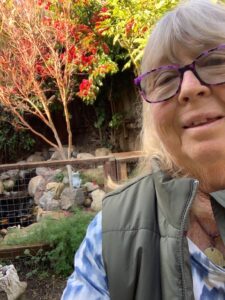 end longer stints on my knees, digging fertilizer into the soil or pressing in new baby plants. With emotions pummeling me on all sides, that simple action of passing among my plants, sprucing them up a bit, talking to them and to myself about the next gardening season, reminds me that every spring life begins anew. So it will be for our nation. On January 20 we will all get a fresh start.
end longer stints on my knees, digging fertilizer into the soil or pressing in new baby plants. With emotions pummeling me on all sides, that simple action of passing among my plants, sprucing them up a bit, talking to them and to myself about the next gardening season, reminds me that every spring life begins anew. So it will be for our nation. On January 20 we will all get a fresh start.
What will you plant in your pandemic garden?
Marlene Anne Bumgarner writes about food, families, and traditions. The author of The Book of Whole Grains, Organic Cooking for (not-so-organic) Mothers and Working with SchoolAge Children, her latest book is about raising children, animals, and vegetables on a rural plot of land in the 1970s. Back to the Land in Silicon Valley was published in July.
Share this post
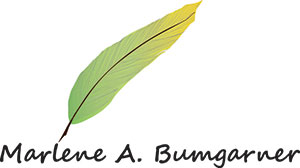
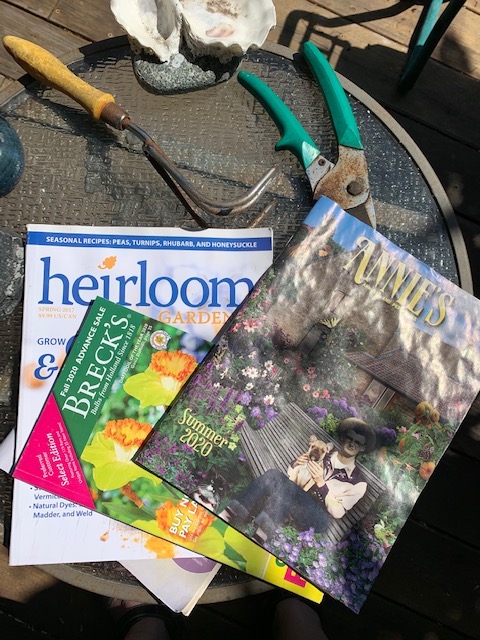



Wonderful memories and recollections! I myself have appreciated gardening by taking a gardening class at my local community college and have become interested in vermiculture composting which has offered healthy fertilizer for my plants. I’m a container and patio gardener but have found success in herbs and kale. I like your analogy of how preparing for the planting of the spring garden welcomes in the hopeful new year . Also, I agree that gardening is so therapeutic especially i during these challenging times. BTW, do you speak to groups about growing eatable plants and your experiences as a gardener/writer /educator?
Sharon,
Great to hear from you and to learn of your own journey into gardening. I also have a worm bin, and garden in containers on my patio, as well as making inroads into the ornamental landscaping in my back garden. Yes, I do speak to groups. You can connect with me via my web page.
Gardening has always been a go-to for me. Not so much food for several reasons but I do love my flowers. Less is definitely not more in this case.
As always, your insights are appreciated!!
Flowers are good . . . !